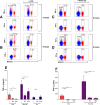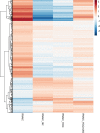Cytokine production by activated plasmacytoid dendritic cells and natural killer cells is suppressed by an IRAK4 inhibitor
- PMID: 30355354
- PMCID: PMC6235225
- DOI: 10.1186/s13075-018-1702-0
Cytokine production by activated plasmacytoid dendritic cells and natural killer cells is suppressed by an IRAK4 inhibitor
Abstract
Background: In systemic lupus erythematosus (SLE), immune complexes (ICs) containing self-derived nucleic acids trigger the synthesis of proinflammatory cytokines by immune cells. We asked how an interleukin (IL)-1 receptor-associated kinase 4 small molecule inhibitor (IRAK4i) affects RNA-IC-induced cytokine production compared with hydroxychloroquine (HCQ).
Methods: Plasmacytoid dendritic cells (pDCs) and natural killer (NK) cells were isolated from peripheral blood mononuclear cells (PBMCs) of healthy individuals. PBMCs from SLE patients and healthy individuals were depleted of monocytes. Cells were stimulated with RNA-containing IC (RNA-IC) in the presence or absence of IRAK4i I92 or HCQ, and cytokines were measured by immunoassay or flow cytometry. Transcriptome sequencing was performed on RNA-IC-stimulated pDCs from healthy individuals to assess the effect of IRAK4i and HCQ.
Results: In healthy individuals, RNA-IC induced interferon (IFN)-α, tumor necrosis factor (TNF)-α, IL-6, IL-8, IFN-γ, macrophage inflammatory protein (MIP)1-α, and MIP1-β production in pDC and NK cell cocultures. IFN-α production was selective for pDCs, whereas both pDCs and NK cells produced TNF-α. IRAK4i reduced the pDC and NK cell-derived cytokine production by 74-95%. HCQ interfered with cytokine production in pDCs but not in NK cells. In monocyte-depleted PBMCs, IRAK4i blocked cytokine production more efficiently than HCQ. Following RNA-IC activation of pDCs, 975 differentially expressed genes were observed (false discovery rate (FDR) < 0.05), with many connected to cytokine pathways, cell regulation, and apoptosis. IRAK4i altered the expression of a larger number of RNA-IC-induced genes than did HCQ (492 versus 65 genes).
Conclusions: The IRAK4i I92 exhibits a broader inhibitory effect than HCQ on proinflammatory pathways triggered by RNA-IC, suggesting IRAK4 inhibition as a therapeutic option in SLE.
Keywords: HCQ; IRAK4; NK; SLE; pDC.
Conflict of interest statement
Ethics approval and consent to participate
The local ethics committee of Uppsala approved the study and informed consent was obtained from all participants.
Consent for publication
Not applicable.
Competing interests
EI, LJ, KT, and JM are employees of AstraZeneca. LR received a research grant from AstraZeneca. The remaining authors declare that they have no competing interests.
Publisher’s Note
Springer Nature remains neutral with regard to jurisdictional claims in published maps and institutional affiliations.
Figures






Similar articles
-
The regulation and pharmacological modulation of immune complex induced type III IFN production by plasmacytoid dendritic cells.Arthritis Res Ther. 2020 Jun 5;22(1):130. doi: 10.1186/s13075-020-02186-z. Arthritis Res Ther. 2020. PMID: 32503683 Free PMC article.
-
Systemic lupus erythematosus immune complexes increase the expression of SLAM family members CD319 (CRACC) and CD229 (LY-9) on plasmacytoid dendritic cells and CD319 on CD56(dim) NK cells.J Immunol. 2013 Sep 15;191(6):2989-98. doi: 10.4049/jimmunol.1301022. Epub 2013 Aug 16. J Immunol. 2013. PMID: 23956418
-
IFN-α production by plasmacytoid dendritic cells stimulated with RNA-containing immune complexes is promoted by NK cells via MIP-1β and LFA-1.J Immunol. 2011 May 1;186(9):5085-94. doi: 10.4049/jimmunol.1003349. Epub 2011 Mar 23. J Immunol. 2011. PMID: 21430220
-
Anti-interferon alpha treatment in SLE.Clin Immunol. 2013 Sep;148(3):303-12. doi: 10.1016/j.clim.2013.02.013. Epub 2013 Mar 1. Clin Immunol. 2013. PMID: 23566912 Review.
-
Toll-like receptor activation in the pathogenesis of systemic lupus erythematosus.Ann N Y Acad Sci. 2005 Dec;1062:242-51. doi: 10.1196/annals.1358.027. Ann N Y Acad Sci. 2005. PMID: 16461805 Review.
Cited by
-
The Therapeutic Landscape of Rheumatoid Arthritis: Current State and Future Directions.Front Pharmacol. 2021 May 28;12:680043. doi: 10.3389/fphar.2021.680043. eCollection 2021. Front Pharmacol. 2021. PMID: 34122106 Free PMC article. Review.
-
TLR7 Protein Expression in Mild and Severe Lupus-Prone Models Is Regulated in a Leukocyte, Genetic, and IRAK4 Dependent Manner.Front Immunol. 2019 Jul 10;10:1546. doi: 10.3389/fimmu.2019.01546. eCollection 2019. Front Immunol. 2019. PMID: 31354711 Free PMC article.
-
DNA Methylation-Based Interferon Scores Associate With Sub-Phenotypes in Primary Sjögren's Syndrome.Front Immunol. 2021 Jul 16;12:702037. doi: 10.3389/fimmu.2021.702037. eCollection 2021. Front Immunol. 2021. PMID: 34335613 Free PMC article.
-
An IRF1-IRF4 Toggle-Switch Controls Tolerogenic and Immunogenic Transcriptional Programming in Human Langerhans Cells.Front Immunol. 2021 Jun 15;12:665312. doi: 10.3389/fimmu.2021.665312. eCollection 2021. Front Immunol. 2021. PMID: 34211464 Free PMC article.
-
Toll-like receptors 7 and 9 regulate the proliferation and differentiation of B cells in systemic lupus erythematosus.Front Immunol. 2023 Feb 15;14:1093208. doi: 10.3389/fimmu.2023.1093208. eCollection 2023. Front Immunol. 2023. PMID: 36875095 Free PMC article. Review.
References
-
- Lovgren T, Eloranta ML, Bave U, Alm GV, Ronnblom L. Induction of interferon-alpha production in plasmacytoid dendritic cells by immune complexes containing nucleic acid released by necrotic or late apoptotic cells and lupus IgG. Arthritis Rheum. 2004;50:1861–1872. doi: 10.1002/art.20254. - DOI - PubMed
Publication types
MeSH terms
Substances
LinkOut - more resources
Full Text Sources

